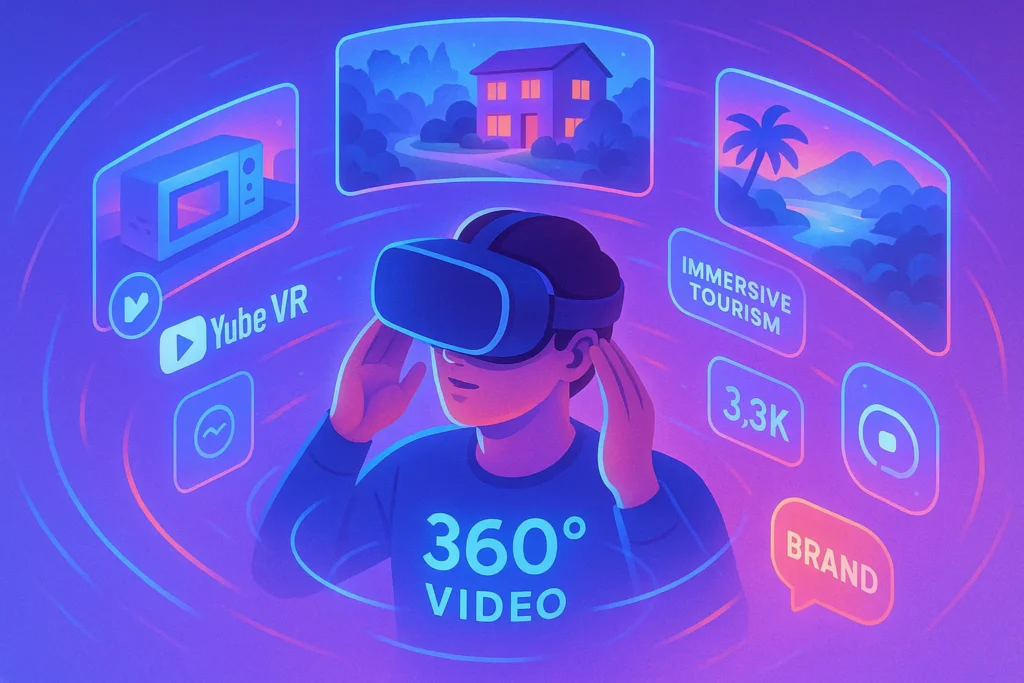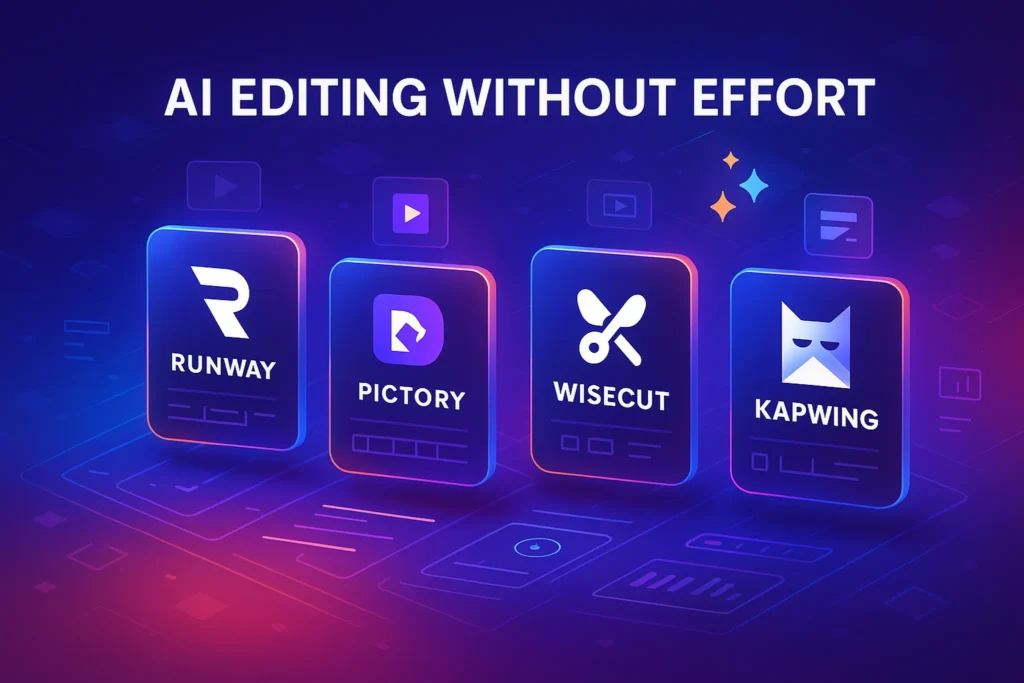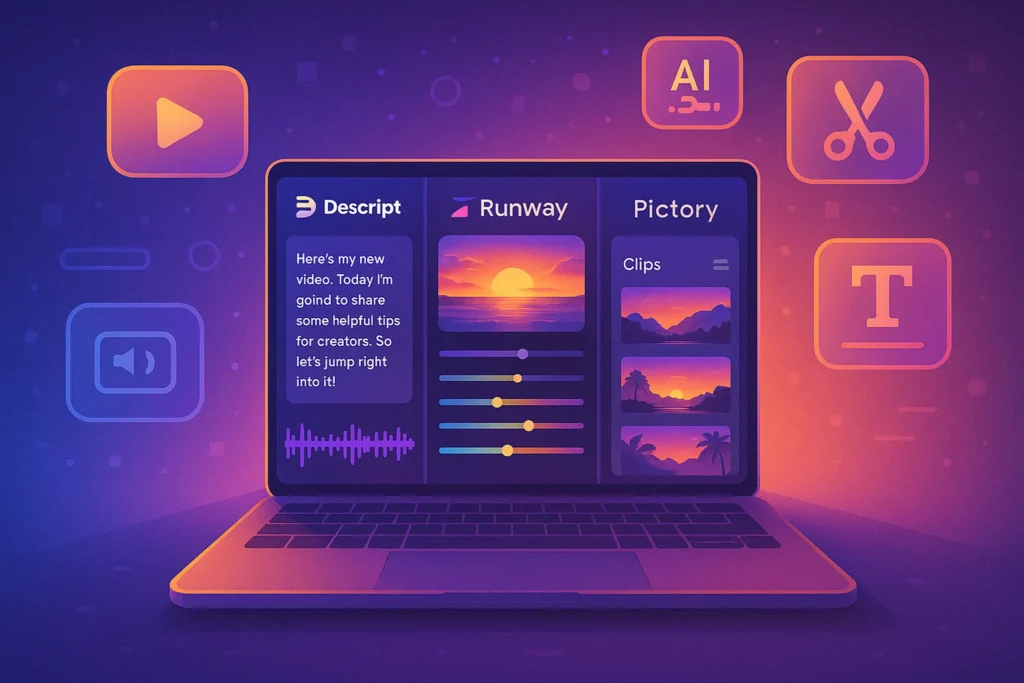🧠 Introduction
In a world where attention is scarce and competition fierce, marketers are constantly looking for ways to break through the noise. Enter VR and 360-degree video—the immersive formats that don’t just tell a story, but put your audience inside it.
Whether it’s giving users a front-row seat to a product demo, a virtual tour of a destination, or a firsthand view of an event, these formats redefine engagement by inviting interaction, not just passive viewing. In 2025, with platforms and hardware becoming more accessible, brands that adopt immersive video are positioning themselves at the cutting edge of attention-based marketing.
But how exactly can you use these tools without a Hollywood budget? Which brands are already winning with them? And is the market really ready?
Let’s break it all down.
🌍 Why Immersive Formats Matter in Marketing Today
Immersive content isn’t a gimmick—it’s a psychological advantage.
Studies show that viewers retain more information when immersed in a virtual experience compared to traditional 2D video. This isn’t just about novelty. It’s about memory, emotion, and connection. When users can look around, choose their angle, and feel like they’re present, the content feels real—and real sells.
Moreover, the metrics back it up. Time-on-page, click-through rates, and even conversion rates see significant bumps when immersive formats are thoughtfully applied.
But it’s not just about the format—it’s about the experience you deliver. To understand this better, we’ll look at how major brands are already leveraging VR and 360° video, and what tools are bringing it within reach.
Key Benefits:
-
🧠 Memory retention is higher with immersive experiences
-
📈 Click-through and engagement rates tend to outperform flat formats
-
🛍️ Product understanding improves when customers “step into” the product or space
-
🌐 Builds brand innovation perception—you signal you’re ahead of the curve
Even short 360° promos on YouTube or Facebook 360 can generate buzz and improve brand recall.
📊 According to recent Video Marketing Trends, immersive content is among the fastest-growing segments—especially in tourism, automotive, and e-commerce.
🏪 How Brands Are Using VR & 360° Videos to Stand Out
Smart brands aren’t waiting for the future—they’re building it.
Take IKEA, for example. The furniture giant has enabled users to virtually walk through kitchens and living rooms using 360° product layouts. This isn’t just visually appealing—it reduces purchase hesitation by letting users visualize space and scale.
Volvo took things a step further by launching a 360° test drive that lets users experience the interior and handling of their vehicles virtually. The campaign didn’t just raise brand awareness—it gave buyers a taste of the emotional connection behind the wheel.
Then there’s Sephora, which introduced immersive tutorials that show products from multiple angles using 360° views. These interactive demos led to increased dwell time on pages and higher conversion rates.
If you want to know what the future looks like, just study the brands already building it.
Want to go deeper into adjacent tech? Our post on Smart Glasses explains how wearables are complementing immersive formats in powerful ways.
Let’s get practical. Here’s how real brands are leveraging immersive formats to create standout marketing campaigns that people remember:
🛋️ IKEA: Virtual Showroom Exploration
Using VR headsets or mobile AR apps, IKEA lets users walk through a virtual kitchen or living room layout. It’s not just fun—it helps convert by reducing buyer hesitation.
🚗 Volvo: The VR Test Drive
In a bold move, Volvo created a 360° test drive experience—so potential buyers could feel the road, the cabin, and the controls… all from their phone or headset. The emotional impact was measurable.
💄 Sephora: VR Makeup Tutorials
Sephora used immersive video in-store and online to show how products look in 3D space—not just in 2D before/after shots. These 360° tutorials increased both dwell time and online purchases.
These aren’t just flashy stunts—they’re strategic moves to build trust, speed up purchase decisions, and enhance brand storytelling.
📌 Curious about how these formats compare to other visual tech? Check out our deep dive on Augmented Reality in 2025, where we explore overlaps with VR.
🎥 Tools to Create VR and 360° Video (Without a Hollywood Budget)
The good news? You don’t need a million-dollar studio to start experimenting.
Thanks to recent hardware advances, you can start creating high-quality immersive content with surprisingly compact gear. Cameras like the Insta360 X3 and GoPro MAX offer intuitive mobile apps, automatic stitching, and direct upload to platforms like YouTube VR and Facebook 360. For real estate professionals or high-end marketing, tools like the Ricoh Theta Z1 offer RAW capture and cinematic control.
If you’re a content creator on a budget, these devices are game-changers. Pair them with software like VeeR Editor or YouTube VR Studio, and you’ll have full control over stitching, timeline editing, and spatial audio without touching pro-level software.
For developers or brands wanting deeper interactivity, platforms like Unity with WebXR can enable web-based VR walkthroughs and product experiences that don’t even require a headset.
And if you’re exploring tools for immersive storytelling, our guide to Top Futuristic Gadgets You Can Own Now can help you build a complete content stack.
You don’t need a massive production team to create compelling immersive content. Here’s how marketers in 2025 are getting started:
🔄 360° Cameras for Plug-and-Play Content
| Camera | Resolution | Price Range | Best For |
|---|---|---|---|
| Insta360 X3 | 5.7K | ~$450 | Versatile content creators |
| GoPro MAX | 5.6K | ~$499 | Action-based 360°, rugged usage |
| Ricoh Theta Z1 | 4K+ RAW | ~$900 | Real estate, premium virtual tours |
📌 These cameras come with intuitive mobile apps, built-in stabilization, and direct upload features to YouTube and Facebook 360.
🧰 Free and Easy Software
-
YouTube VR Upload Tool – simple interface for 180° and 360° uploads
-
Facebook 360 Video Studio – optimized for social playback
-
VeeR Editor – mobile-friendly, intuitive 360° timeline editing
-
Unity + WebVR – for advanced interactive VR development
🔧 Whether you’re creating an immersive ad or a behind-the-scenes tour, these tools lower the barrier to entry.
📬 Want More Insights on Future Video Formats?
Subscribe to our Newsletter and get weekly tips on immersive content, creator tools, and campaign trends—delivered straight to your inbox.
🔐 100% privacy. No fluff. Just powerful insights to keep your brand ahead of the curve.
📣 How to Distribute and Promote VR/360° Content Effectively
Once you’ve created your immersive video, the next big question is: Where will people experience it?
The distribution strategy makes or breaks your VR efforts. Fortunately, the biggest platforms are ready for immersive content:
-
YouTube VR supports 180° and 360° videos with seamless playback on desktop, mobile, and most headsets (Meta Quest, HTC Vive, etc.).
-
Facebook 360 allows native immersive playback in the feed, complete with reactions and sharing.
-
VeeR and SteamVR are great for niche content or branded VR experiences, particularly in the travel and event sectors.
-
Your own website, via WebXR, is the most brand-controlled path—embedding 360° content directly into product pages or landing flows.
💡 Smart Tip: Embed short teaser versions of your 360° videos in regular blog or social content. Then, funnel interested users into the full immersive experience. This extends dwell time and helps gauge serious engagement.
For complementary strategies on real-time formats, see our breakdown of Live Streaming 101 for timing-based engagement.
Creating a great immersive video is only half the battle—distribution is where the magic happens.
📺 Where to Publish:
-
YouTube VR → Supports 360° and stereoscopic formats. Works with Cardboard, Meta Quest, and more.
-
Facebook 360 → Seamless native playback on mobile and desktop with embedded engagement tools.
-
VeeR, Littlstar, SteamVR → Niche platforms for creative VR storytelling or branded experiences.
-
WebVR on your site → Embed 360° product tours or virtual events directly into your brand’s landing page.
🧠 Pro Tip: Consider embedding short VR teasers in regular content. Then link to full immersive versions—this increases dwell time and funnels attention.
🛒 Recommended VR Cameras for Creators
🎥 Want to Try Immersive Video for Your Brand?
These top-rated VR and 360° cameras are perfect for creators getting started:
- Insta360 X3 – Lightweight, flexible, and app-powered editing
- GoPro MAX – Durable and perfect for action storytelling
- Ricoh Theta Z1 – Exceptional clarity for real estate and virtual tours
🧠 Nerd Tips: When and Where to Use VR/360° in Your Marketing Funnel
Immersive content works best when it’s intentional—not gimmicky.
🎯 Best Use Cases for Marketers:
-
Top-of-Funnel Awareness → Create buzz with 360° brand stories or event coverage
-
Middle-of-Funnel Education → Virtual product demos, interactive explainers
-
Bottom-of-Funnel Conversion → Real estate walk-throughs, “try-before-you-buy” VR previews
📌 For B2B marketers: use 360° content in demo calls, showrooms, or digital trade booths.
Curious how immersive formats tie into wearable tech? Explore our take on Smart Glasses, where content goes hands-free and always-on.
🎛️ Nerd Tips for VR & 360° Viewers
Creating immersive content is one thing—guiding the viewer’s experience is another.
Many 360° and VR videos fail not because the content is bad, but because the user doesn’t know what to do. That’s where micro-interactions and subtle UX nudges make all the difference.
🎯 Best Practices to Enhance Viewer Experience:
-
👆 Add on-screen cues like “Swipe to look around” or “Drag to explore”
-
🎯 Position text and key visuals in the viewer’s central field of view
-
⏱️ Keep it short: 90 to 120 seconds is the sweet spot for engagement
-
🔁 Include a “Switch to standard view” button for mobile or desktop fallback
-
🎧 Always test with headphones—audio direction enhances spatial immersion
These small touches help users feel in control—making your immersive content feel polished and professional, not confusing or clunky.
🔮 What’s Coming Next in Immersive Marketing?
If you think VR and 360° are impressive now, just wait.
Immersive tech is evolving fast, and brands that prepare for the next wave will own the future of attention.
🚀 Here’s What’s on the Horizon:
-
🧠 Apple Vision Pro SDK is enabling 3D spatial ads—interactive objects in real-world environments
-
🛒 WebXR integration will soon let customers walk through 360° product demos inside e-commerce sites
-
🎥 Volumetric video (6DoF) is emerging, allowing viewers to move freely inside a moment—not just rotate
-
📱 TikTok and Meta are experimenting with immersive short-form ad formats (180° tilt-to-engage reels)
Immersive storytelling is not just a trend—it’s the next leap in empathy-based marketing.
Are you ready to lead, or will you play catch-up?
🧩 Who Should Use What?
| 👤 Brand Type | 🧠 Best Use of VR/360° | 💡 Why It Works |
|---|---|---|
| Retail & DTC | 360° product tours, virtual try-ons | Boosts confidence & lowers returns |
| Automotive | VR test drives, vehicle showcases | Emotional storytelling + technical clarity |
| Real Estate | Virtual walkthroughs | Saves visits, improves buyer intent |
| Education & Training | Immersive onboarding or explainer | Higher retention and faster understanding |
| Travel & Tourism | 360° destination previews | Sparks desire by showing, not telling |
🧠 Nerd Verdict
If you want your brand to stand out in a sea of sameness, immerse your audience—don’t just pitch them.
VR and 360° videos offer storytelling superpowers that static or even cinematic video can’t match. As tools become more affordable and platforms more immersive, early adopters will own the attention economy.
So go beyond the frame—and invite your users in.
❓ FAQ: Nerds Ask, We Answer
💬 Would You Bite?
🌀 If you could give your audience a 360° view of any part of your business… what would you show them?
Tell us in the comments 👇—we might even feature your idea in our next tech trends roundup.



